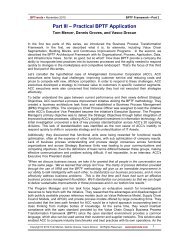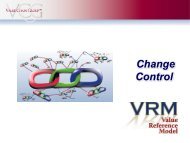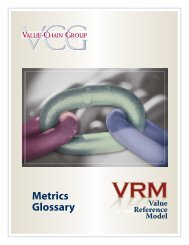Transitioning from - Value Chain Group
Transitioning from - Value Chain Group
Transitioning from - Value Chain Group
Create successful ePaper yourself
Turn your PDF publications into a flip-book with our unique Google optimized e-Paper software.
S&OP is a Simple, Common-Sense Process for Aligning<br />
Company Plans Every Month<br />
This evolving S&OP/IBP process should have key<br />
performance indicators and metrics. Effectively<br />
used KPIs and metrics help to understand<br />
performance to date and projected performance<br />
into the future. The use of information<br />
dashboards is important to easily monitor the<br />
KPIs and business drivers.<br />
Figure 2 – S&OP/IBP Process Model<br />
plans. Development of improved demand plans<br />
is dependent upon a better understanding of<br />
markets, customers, technology, and the outside<br />
influences on the business.<br />
In short, the focus of attention on S&OP has<br />
been shifting toward a better understanding of<br />
the external environment as well as ensuring<br />
alignment and<br />
Definition of S&OP - The traditional<br />
definition of Sales and Operations<br />
Planning is transitioning to Integrated<br />
Business Planning with a more strategic<br />
management focus.<br />
synchronization<br />
among the<br />
internal<br />
functions of the<br />
company, which<br />
was originally<br />
S&OP’s primary<br />
objective. The shift<br />
toward strategic<br />
management is<br />
a key driver in<br />
the transition<br />
to Integrated<br />
Business Planning<br />
(IBP).<br />
As Sales and<br />
Operations<br />
Planning has<br />
become more<br />
driven by strategy, understanding and using the<br />
business drivers in planning is becoming more<br />
clearly understood. In addition to the traditional<br />
attention to supply chain management, the use<br />
of Business Intelligence (BI) has begun to enable<br />
a company’s S&OP process to be more about the<br />
“Essence of the Business.”<br />
The best practice multi-step model for S&OP (see<br />
Figure 2) has changed relatively little over recent<br />
years, but its focus of attention has continued<br />
to evolve toward business strategy. So, while<br />
the “boxes” in the figure remain the same,<br />
what happens inside each review has evolved<br />
to a greater understanding of the business<br />
environment and linkage to strategy. This, in turn,<br />
has made it paramount that the leaders of the<br />
business both lead and are actively involved in the<br />
process. (See Sidebar, “Definition of S&OP.”)<br />
<strong>Transitioning</strong> to Strategic<br />
Management Requires Extending the<br />
Planning Horizon<br />
In order to transition to strategic management,<br />
the focus of attention must move further out<br />
in time. One of the pitfalls that companies<br />
experience is a continual focus of attention on<br />
the near term … this month, this quarter, and<br />
this year (as the year end approaches.) One key<br />
but simple and straightforward approach is to<br />
extend the planning horizon. The management<br />
and leadership team should be able to speak<br />
not only to the near term but also to the full<br />
planning horizon. It is strongly encouraged that<br />
companies utilize a minimum of a 24-month<br />
rolling planning horizon. Anything less does not<br />
naturally encourage strategic thinking. 3 Use of<br />
an extended planning horizon enables better<br />
decision-making involving what is commonly<br />
called “gap management.” (See Figure 3.) Here’s<br />
how gap management works:<br />
The current plan is reviewed. This current plan<br />
should reflect reality as we know it, based<br />
upon facts and assumptions. The current plan<br />
is compared to previous targets or goals. This<br />
comparison enables identification of projected<br />
gaps in performance.<br />
2







